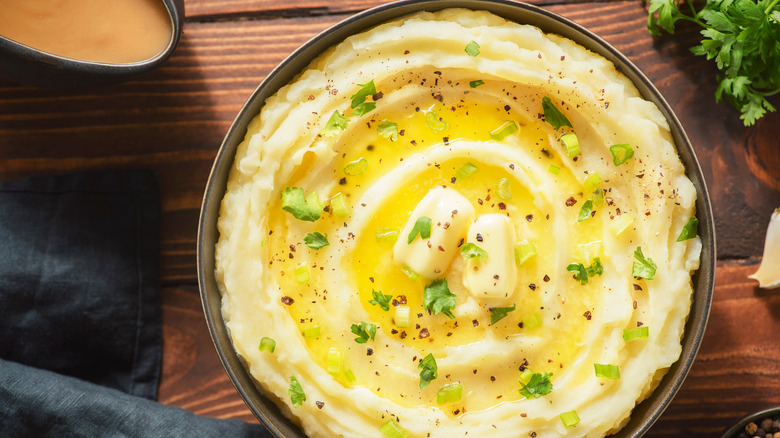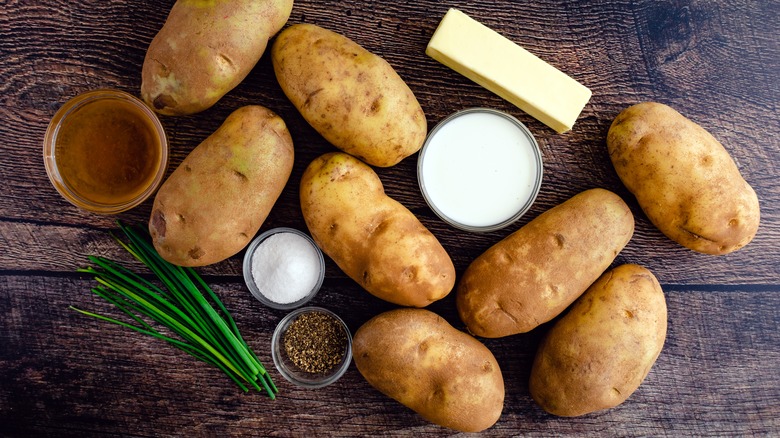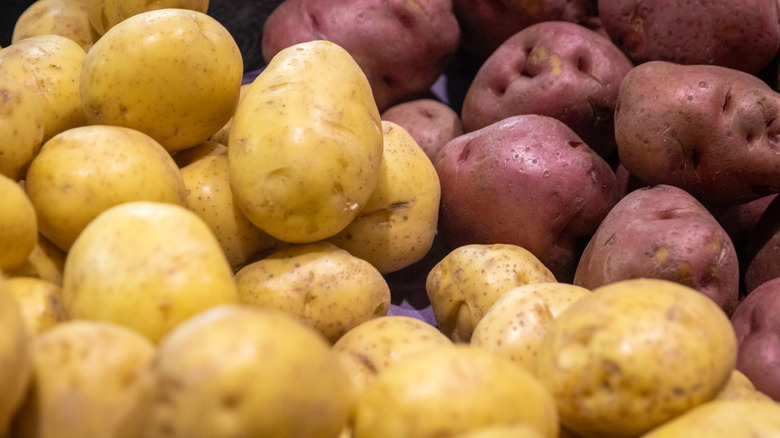How Potato Varieties Affect The Texture Of Your Mash
As mashed potato season comes into full swing with dropping temperatures and cozy holidays approach, the types of potatoes in your shopping cart at the grocery store are going to shift. But as you find yourself standing in front of a display of different varieties, it can be hard to know which ones you need.
That choice all comes down to what kind of mashed potatoes you want to serve. Do you want fluffy mashed potatoes? Chunky mashed potatoes with bits of skin? Creamy mashed potatoes? Super-rich pommes purée? These will call for different kinds of potatoes based on the starchiness or waxiness of the variety.
The simple rule to remember is that waxy potatoes should be used for mash with a really creamy texture, and starchy potatoes should be used for mash with a really fluffy texture. For a chunky skin-on mash, it's as much about the texture of the potato as it is about the texture of the skin; too thick or rough skin and it creates a lot of fibrous chewing. An all-purpose potato like the Yukon Gold, which has characteristics of both waxy and starchy potatoes but with a thin skin, is ideal here. But for a fluffy mash or a rich, creamy mash, you'll want something different.
Mashed potatoes with starchy varieties
What makes a potato starchy? Starchy or floury potatoes are so-named because they have a high starch content and low moisture content. Starchy potatoes include russet, Idaho, which are russet potatoes grown in Idaho, and sweet potatoes. They are ideal for a fluffy mashed potato dish.
It's the particular starch content — amylose and amylopectin, primarily — to moisture content ratio that makes these potatoes the perfect choice for a fluffy mash; they break down easily, requiring less work to mash them. Russets have more amylose than amylopectin, making them crumble more easily, leading to fluffier potatoes if handled correctly. As with any potato, those two starch molecules can result in gluey potatoes when over-mashed.To get fluffy, light, smooth mashed potatoes, use a food mill or potato ricer to mash your russets. By putting your potatoes through a potato ricer or food mill with small holes instead of whipping or beating or using a potato masher, fewer molecules will burst.
Other tips for handling high starch, low moisture potatoes: Their construction makes them particularly vulnerable to getting waterlogged during boiling, so it's best to boil them whole and skin-on. Once drained, let the potatoes cool for a couple of minutes before handling; the skins will slide right off. When combining with whatever butter or dairy you're using, stir lightly just to combine. The result will be ethereally light and fluffy mashed potatoes.
Mashed potatoes with waxy varieties
Waxy potatoes have a higher moisture content and lower total starch content than starchy potatoes and a higher ratio of amylopectin to amylose. Waxy varieties include red potatoes, fingerlings, new potatoes, and baby potatoes. These potatoes are best for high-fat preparations like Joël Robuchon's signature pommes purée, which included a 2:1 potato-to-butter ratio by weight, or the cheesy French mashed potato dish aligot, which has the same 2:1 ratio of potato to cheese.
Really luxurious, decadent, dense, creamy mashed potatoes need to be able to hold more butter and cream than fluffy mashed potatoes, so they need to be able to be stirred more. Using a starchy potato for pommes puree won't be luxurious; it will be gummy by the time you've incorporated all that butter. A waxy potato variety — or even an all-purpose variety like Yukon gold — on the other hand, can stand up to slightly rougher treatment than a starchy variety. Because it has less amylose, it can be worked more to incorporate fatty dairy ingredients in a higher proportion.
Because they hold their shape when cooked so well, it's still best practice to use a food mill or ricer to mash waxy potatoes versus throwing them into a stand mixer — and you should never mash your potatoes in a food processor. Their increased durability over starchy potatoes, though, means you can really stir them to incorporate all the butter for a rich, creamy mash.


